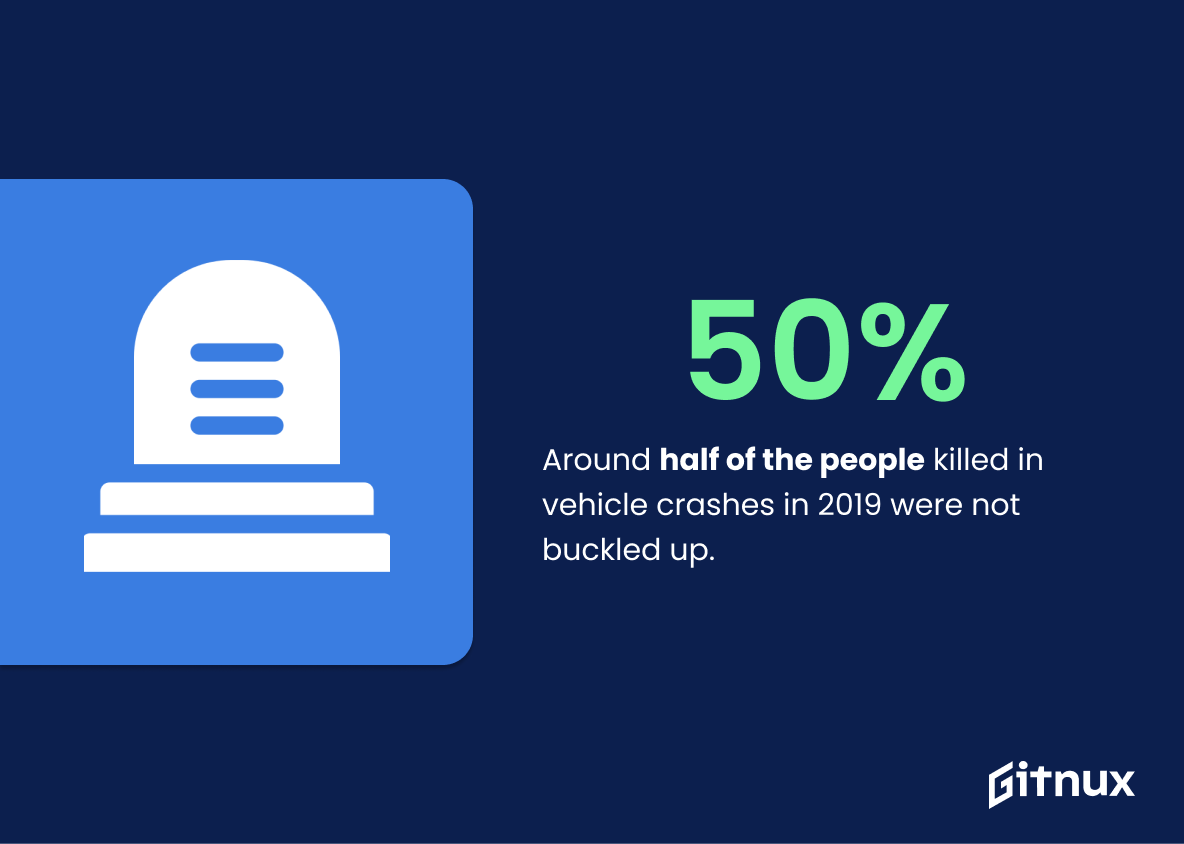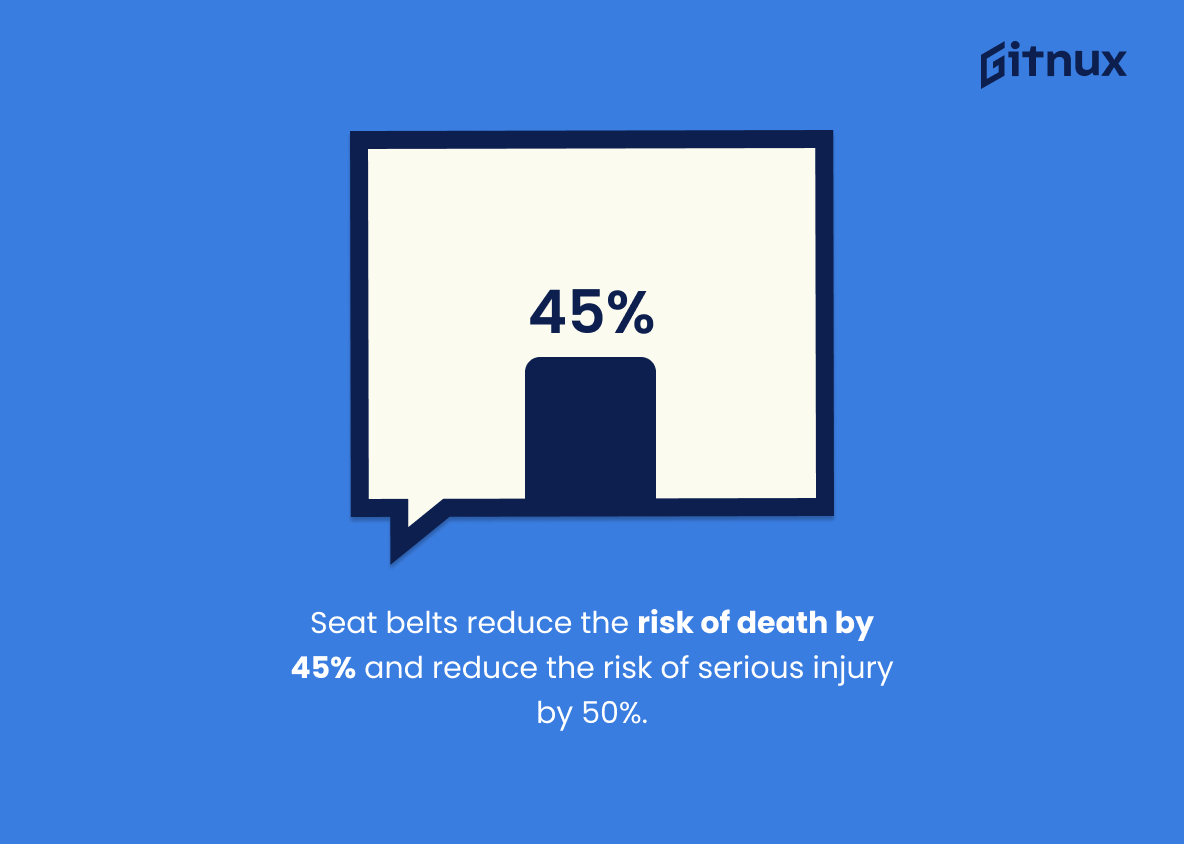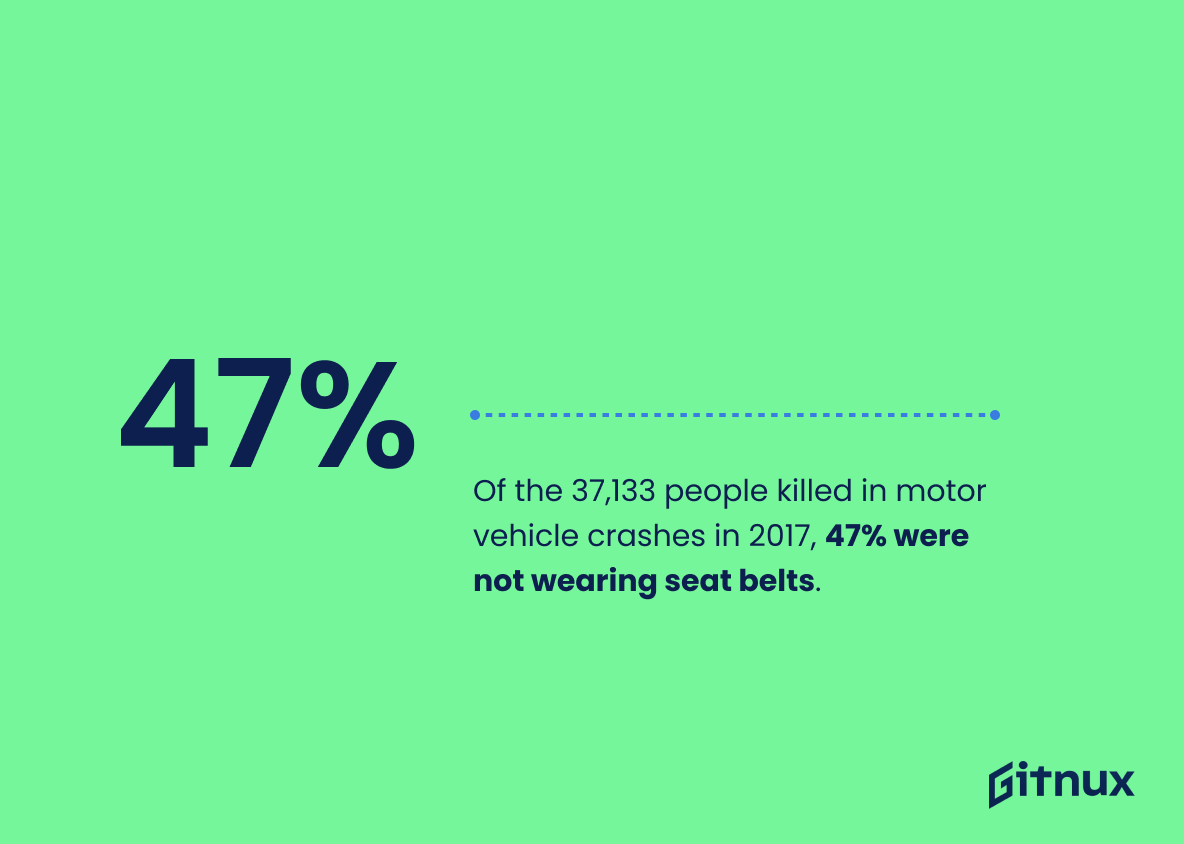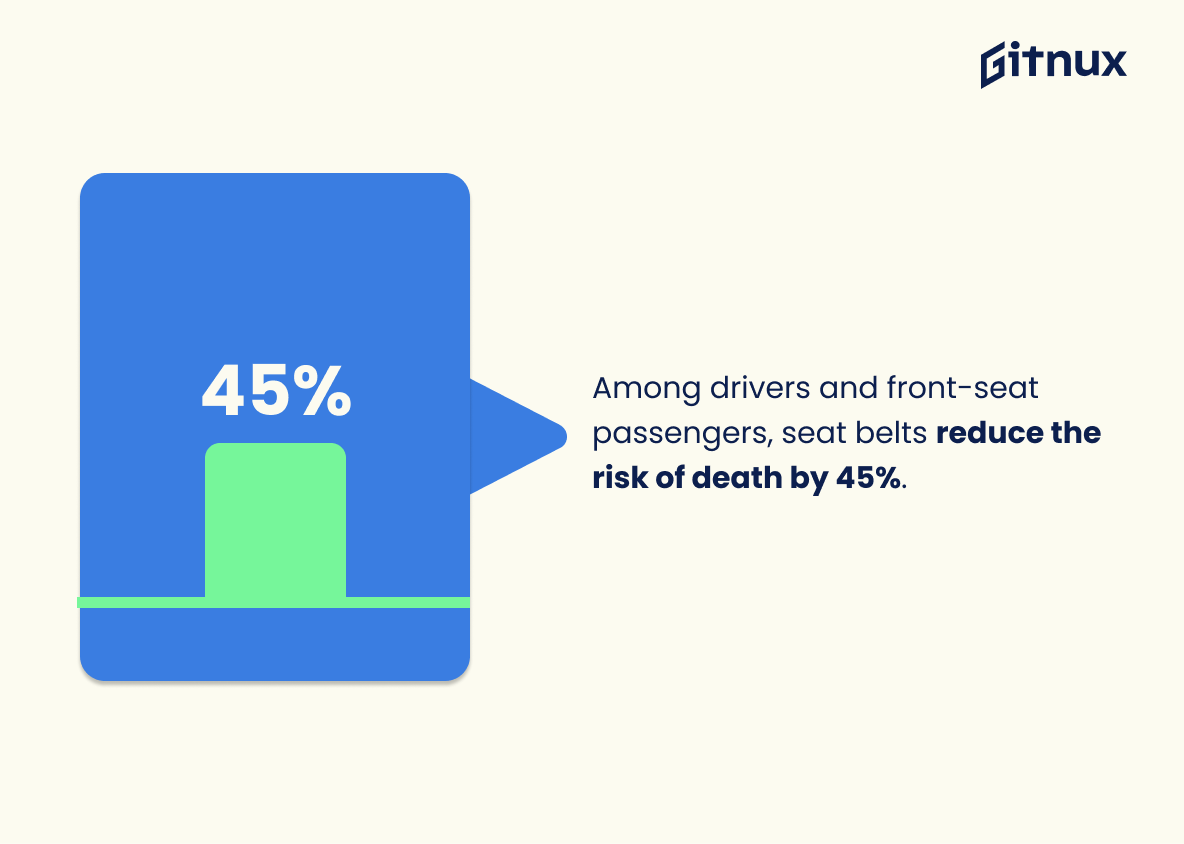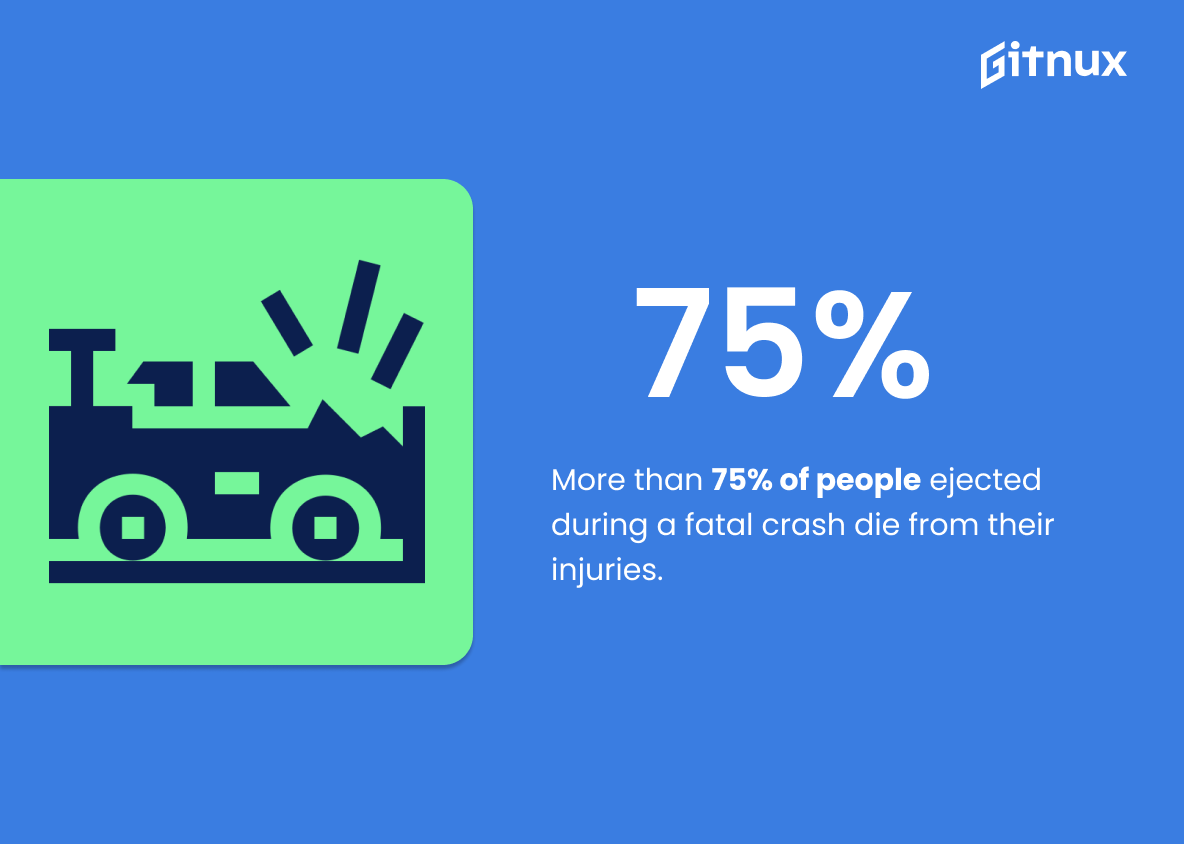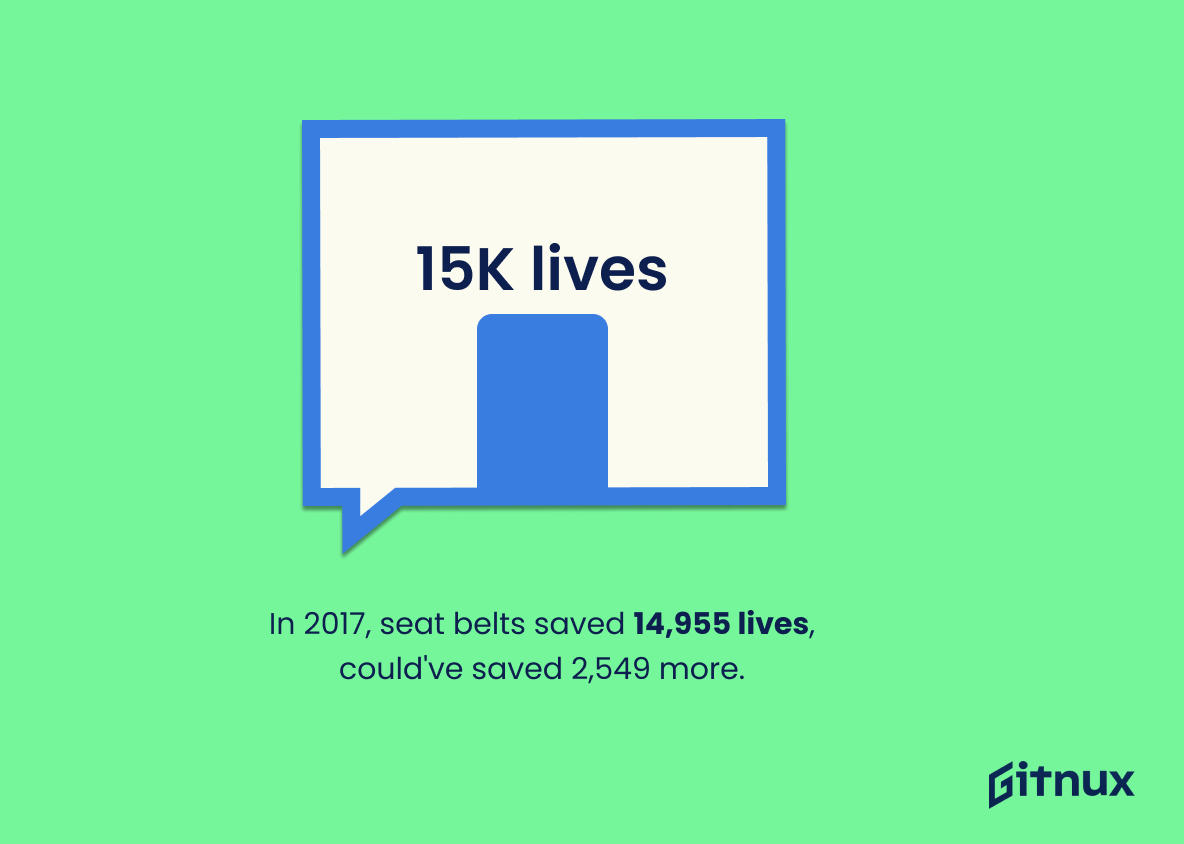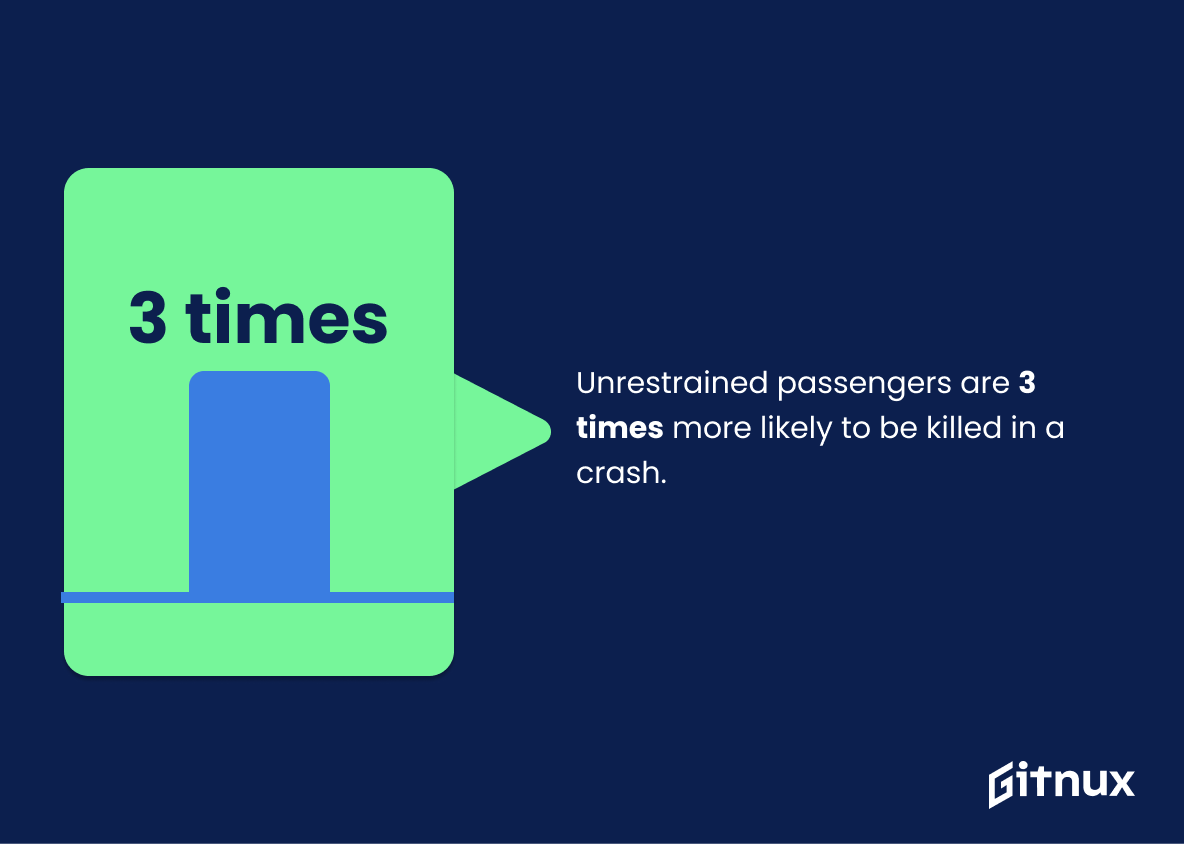Fasten your seat belts and prepare to embark on an enlightening journey through the crucial yet often unheeded world of seat belt safety. We’re going beyond the mandatory “click it or ticket” reminders to help you truly understand the life-saving power this simple vehicle feature holds.
With an array of eye-opening statistics at our disposal, this post not only underscores the significance of seat belt usage but also relays the inescapable reality of the grim consequences associated with neglecting to click that belt. So buckle up, as these seat belt safety statistics will undoubtedly transform your approach to road safety, ensuring every journey you embark on, whether short or long, becomes a secure one.
The Latest Seat Belt Safety Statistics Unveiled
Around half of the people killed in vehicle crashes in 2019 were not buckled up.
In the world of seat belt safety, certain numbers can paint a vivid picture that cannot be ignored. When confronted with the reality that half of the people who lost their lives in 2019 vehicular crashes did not have their seat belts fastened, it becomes a catalyst for motivation to educate and advocate for seat belt safety. This statistic gives gravity to our discourse; every tick of that proverbial seat belt counter is not just about laws or rules, but the preservation of life itself.
It underscores the urgency and scale of this issue in a powerful way lending credence to the perceptible and potent connection between seat belt use and survival in vehicle crashes. This particular statistic isn’t just a number, but a solemn chorus whispering, urging, and imploring every passenger weaved into our global tapestry to simply buckle up.
Seat belts reduce the risk of death by 45% and reduce the risk of serious injury by 50%.
Unbuckling the mystery, the fascinating statistics that ‘Seat belts reduce the risk of death by 45% and shrink the chances of serious injury by half’ encapsulates the very essence of the seat belt safety discourse. Painting with a broad brush, they underscore the life-saving potential of this simple tool. Within the narrative of this blog post on Seat Belt Safety Statistics, these figures serve as inalienable proof, a factual cornerstone in the argument of diligence and caution on the roads.
They do not merely weigh in hypothetical scenarios but catalyze a visual image of a safer reality, a 45% stronger wall against death and a 50% reinforced shield against severe injuries. The power of these figures lies in their simplicity and weight, cutting through the fog of confusion and doubt, resonating with the urgency of seat belt utilization. Delving into the depth of these statistics enlightens readers on the power of decision, punctuating every journey with the click of the seat belt.
Of the 37,133 people killed in motor vehicle crashes in 2017, 47% were not wearing seat belts.
Woven into the fabric of the narrative around Seat Belt Safety Statistics, we cannot ignore the stark revelation that in 2017, 47% of the 37,133 lives snuffed out in motor vehicle crashes were individuals who made the fatal mistake of not buckling up. This undeniable scope of human tragedy highlighted vividly draws attention to how a simple click can be a boundary between life and death.
It serves as a poignant reminder to all readers to put on their seatbelt, offering food for thought to the skeptics and reinforcing the mantra of safety to the believers, ultimately forming a critical piece in the larger puzzle of road safety awareness.
Among drivers and front-seat passengers, seat belts reduce the risk of death by 45%.
Envision the illuminating beacon of safety, the humble seat belt, as a lifeguard in the tumultuous seas of traffic. It carries a superpower, a heroic ability to lessen the fatality risk by a staggering 45% among drivers and front-seat passengers. Imagine it acting like a shield, valiantly fending off potential dangers on your every journey. This statistic, standing proud and firm, asserts the impact of this life-saving contraption.
In a blog post about Seat Belt Safety Statistics, this figure breathes life into the narrative – emphasizing the crucial role seat belts play in preserving lives, and improving the odds during unfortunate events on the road. It’s a message that rings loud and clear – buckle up, it could be the difference between life and death.
Persons not wearing a seat belt are 30 times more likely to be ejected from the vehicle during a crash.
Envision the horror of a car crash, the violent jolt, the airbag exploding, and the sheer force exerted on your body. Now, imagine the same scenario but without a seat belt – a free fall amidst shards of glass and hard steel, a grisly prospect indeed. This is where the statistic makes its grand, life-saving appearance: those foregoing a seat belt are 30 times more inclined to be catapulted from their vehicle amidst a collision.
Highlighting such a dramatic difference underscores the irrefutable power of a simple click of a seat belt, turning raw numbers into persuasive storytelling. This potent data point serves as an impactful tool, heightening the unsettling reality of neglecting such a basic safety measure.
This statistic forms the backbone of an authentic narrative in the larger discourse of seat belt safety – presenting evidence as to why buckling up isn’t just the law, it’s a game-changer between life and death. It paints a vivid picture of the potential consequences of not wearing a seat belt, piercing through apathy and igniting a sense of urgency among the readers to consciously adhere to this lifesaving habit.
More than 75% of people ejected during a fatal crash die from their injuries.
Highlighting the deterrent fact that over three-quarters of people who are thrown out during deadly accidents succumb to their injuries serves as a sobering reminder of the immense importance of using seatbelts. When couched in the broader conversation about Seat Belt Safety Statistics, this illustration starkly draws attention to the literal life-or-death contrast that something as simple as fastening your seatbelt can make.
It underlines the urgency of ensuring that seatbelts are not an afterthought but a vital safety habit. Thus, it reminds everyone, drivers and passengers alike, that taking a few seconds to click the seatbelt into place could be the thin line separating survival from mortality during a car crash.
In 2017, seat belts saved an estimated 14,955 lives and could have saved an additional 2,549 people if they had been wearing seat belts.
This powerful revelation offers a stark testament to the life-saving potential of seat belts. Imbedded in the data is a compelling narrative of nearly 15,000 individuals who, through the simple act of buckling up, dramatically increased their chances of survival during road accidents. However, the numbers also echo a somber reminder with the mention of 2,549 lives that could have possibly been spared, had they also adhered to this safety measure.
The reality painted by this statistic forcefully illuminates the non-negotiable significance of seat belts in our everyday road safety in the blog post about Seat Belt Safety Statistics. Beyond mere numbers, these figures lend a voice to those saved – and tragically lost – underscoring the urgent need for all passengers to wear seat belts consistently and correctly.
In 2016, 10% of all vehicle occupants killed in crashes were teens, and 56% of them were not wearing a seat belt.
Highlighting the stark reminder carried within these 2016 statistics, the narrative of seat belt safety clearly unwinds. Positioned alarmingly in the spotlight, the underused lifelines we know as seat belts stand out. Teens, making up a significant 10% portion of all vehicle occupant fatalities, pushes the urgency to the forefront.
Amplifying the gravity further, an astonishing 56% of these unfortunate teens were found without their seatbelt – one of the simplest forms of protection. Therefore, in our discourse about seat belt safety, such statistics underscore the importance of the issue and stand as a sobering testament to the price of neglecting seat belt usage, particularly among the younger population.
Unrestrained passengers are 3 times more likely to be killed in a crash.
In the realm of Seat Belt Safety Statistics, consider this information as the pivotal anchor. It emphasizes that unrestrained passengers run a triple risk of losing their lives in a crash. Not just a double, nor an equal, but a strikingly high threefold risk.
This statistic serves as a chilling reminder that a momentary decision—clicking or not clicking that seatbelt—can drastically alter the outcome of an unforeseen accident. A potent testament to the life-saving power of seatbelts, this statistic casts a critical spotlight on the indispensable need for seatbelt usage in all vehicular travel, no matter how short or seemingly risk-free the journey.
The primary seat belt law increased safety belt usage by 45%.
Showcasing a staggering uptick of 45% in seat belt usage due to the primary seat belt law brilliantly illustrates the compelling power of law enforcement on human behavior. It breathes life into the abstract principle of safety regulations, transforming it into a concrete, measurable improvement in citizens’ habits.
This notable percentage change underscores the potency and necessity of policies promoting seat belt use, reinforcing the life-saving message of our blog post on Seat Belt Safety Statistics. Furthermore, it takes the readers on a journey, showing them an encouraging picture of risk reduction and enhanced safety on our roads. Ultimately, it solidifies the blog’s purpose, offering raw, real-world proof that seat belts do save lives, and laws enforcing their usage work.
One in seven people don’t wear a seat belt while driving.
Picturing the growing proportion of seat belt non-users is analogous to imagining a full week, seven days, each day representing a person. It’s startling to realize that when Sunday rolls around, that ‘Sunday person’ disregards a life-saving opportunity: buckling up. The frightening impact? This one defiant act magnifies the risk of severe injury or even death in the unpredictable event of a collision.
For a blog post devoted to seat belt safety statistics, this ‘Sunday person’ example is crucial—it visually emphasizes the extent of the problem. By quantifying the negative behavior, it snaps readers’ attention into focus, highlights the urgency of increased seat belt awareness and promotes better safety practices. It’s a constant, unnerving reminder that every seventh person out there potentially toys with their life each time they ignore the click of a seat belt.
Seat belt use in passenger vehicles saved an estimated 15,000 lives in 2017.
When we delve into the fascinating world of Seat Belt Safety Statistics, this particular data point demands our undivided attention – ‘Seat belt use in passenger vehicles saved an estimated 15,000 lives in 2017.’ Glancing at this number, it’s clear as day that these fabric lifesavers are living up to their name.
Diving deeper, this stat amplifies the efficacy and importance of seat belts, sending across a compelling message. In 2017 alone, enough lives were preserved to populate a small town, all thanks to the act of buckling up. In a blink, a seat belt can change the narrative from potential tragedy to survival.
So when we talk Seat Belt Safety Statistics, consider this figure – 15,000 lives saved. It isn’t just a statistic. It’s a chorus of thankfulness from thousands who lived to tell the tale, an echoing reminder of survival whispering about the power of seat belts. Now, isn’t that something to fasten your thoughts upon?
In 2019, seat belt use in the United States ranged from 70.7% in New Hampshire to 97.1% in Hawaii.
Reflecting on the intriguing variability of seat belt usage across the United States in 2019, we can uncover considerable wisdom about our collective approach to safety. Fascinatingly, the range swung from 70.7% in New Hampshire to a lofty 97.1% in Hawaii, offering an expansive lens of comparison and insight. This crucial figure lays bare the disparities in adherence to established seat belt laws and safety customs, thus foregrounding the compelling need for targeted awareness initiatives.
Additionally, this disparity invites further probing into the confluence of regional culture, legal systems, and public health outcomes. Hence, we are offered a statistical mosaic that insists on the importance of continuous dialogue, informed advocacy, and effective policy-making in the sphere of seat belt safety.
Children aged 8-12 are less likely to use seat belts compared to other age groups.
In the realm of Seat Belt Safety Statistics, the truth about the underuse of seat belts among children aged 8-12 stirs a formidable concern. Delving deeper into the intricacies of this data could unravel critical information, allowing for the development of targeted strategies and interventions.
As these figures shine a light on this specific age group’s complacency or ignorance towards seat belt use, they underscore the urgent need for educational initiatives and policy enforcement to ensure their safety. Ultimately, these alarming trends serve as a springboard for crucial discourse and transformative action, highlighting the inseparable link between seat belt use, age, and overall road safety.
In 2017, seat belts saved nearly 15,000 lives, but nearly 2,549 additional lives could have been saved if everyone had buckled up.
Highlighting these figures sends a potent message, underlining the urgency and importance of seat belt use. Let’s face it, 15,000 saved lives is a staggering testimony to the power of that simple click before speeding off. However, the juxtaposition of this figure with the disheartening loss of an additional 2,549 lives, drives home the tragic cost of neglecting this important safety measure.
It underscores just how many more individuals could still be with us today, contributing their uniqueness to our world, if they had just taken that few extra seconds to buckle up. Weaving this statistic into the tapestry of a blog post paints a vivid and compelling picture of seat belt safety, providing tangible evidence of the unmistakable difference it makes. It’s a sobering yet powerful call for all drivers and passengers to prioritize safety, illustrated with heartbreaking clarity by numbers that truly hit home.
Parents who do not wear a seat belt are 21.6 times more likely to have children who also do not wear seat belts.
Unbuckling the profound implications of this statistic reveals the contoured dimensions of a family impact phenomenon. It undeniably casts a glaring light on how parental habits significantly shape children’s perception and practice of safety measures.
The multifold elevated likelihood of children mimicking the unsafe behavior of their parents – a staggering 21.6 times – paints a stark but irrefutable picture of the ripple effect triggered by a single act of neglecting seat belt safety. It underlines the paramount role parents hold as immediate role models in their children’s lives, not just in abstract values, but also in pragmatic everyday routines such as the wearing of seatbelts.
Imagine each car journey without a seat belt as a roll of the dice, exposing the roller to potential peril. Unfortunately, these dice aren’t exclusively thrown by the parent. Every act of their carelessness leaves an impression, leading children to follow their parent’s gamble with their own safety. It’s no longer just one person playing with fate, but the whole family.
In the continuum of seat belt safety statistics, these numbers cannot be brushed off. They emphasize how fundamental the reiteration of a safety culture is, starting from the microcosm of our homes. The narrative of prevention must thus begin with an individual, even more so when the individual is a parent. Therefore, as we delve into discussing seat belt safety, let us remember: proper practices begin at home.
Seat belt usage reduces the chance of fatal injury to front seat car occupants by 45% and the risk of moderate to severe injuries by 50%.
In a blog post dedicated to Seat Belt Safety Statistics, one cannot understate the role of the stated statistic, ‘Seat belt usage reduces the chance of fatal injury to front seat car occupants by 45% and the risk of moderate to severe injuries by 50%.’ It essentially acts as a robust witness, testifying the dramatic impact seat belt usage has on enhancing car safety.
Arming ourselves with this knowledge illuminates the lives potentially saved and debilitating injuries averted through this simple act. The statistic is further potent, for it provides credible grounds for advocacy and awareness-promoting initiatives to further car safety worldwide. Beyond its informational significance, it is also a powerful rhetoric, defeating any arguments against seat belt usage, owing to the significant decrease in the odds of fatal and severe injury it demonstrates.
Men are 10% less likely to wear seat belts than women.
Diving deep into the heart of seat belt safety statistics, one stark revelation emerges from the shadows – men taking the road less traveled and are 10% less inclined to fasten their seat belts compared to women. This isn’t just an everyday data point, ladies and gentlemen, it’s a pivotal signifier reflecting on vehicular safety norms and gender-based behavior patterns.
In the realm of seat belt safety statistics, staying abreast of such differences helps us tailor the right strategies, make the necessary noise, and shape appropriate policies or campaigns. There’s clearly a significant opportunity here to heighten male participation in adhering to seatbelt laws and consequently, reduce road fatalities. After all, a small click goes a long way in saving lives, and every percentage point counts. Let’s not shy away from the glaring disparity, but instead face it head-on, steering our way towards a safer roadway community.
Among adults aged 18 years or older, Hispanics (23%) and non-Hispanic blacks (20%) were more likely than non-Hispanic whites (10%) to not wear a seat belt all the time.
Diving into the ultimate relevancy of this statistic within a blog post about Seat Belt Safety Statistics unveils an unexpected tapestry of demographic distinctions. As we peel back the layers, we can unveil apparent disparities in safety habits between various ethnic groupings. The heightened propensity of Hispanics (23%) and non-Hispanic blacks (20%) to forgo seat belts compared to non-Hispanic whites (10%) provides a pivotal point of discussion.
It prompts further investigations into the underlying factors that could be driving these differences, such as cultural conceptions of safety, perceptions of law enforcement, or possible socio-economic influences that impact education and access to information about seat belt safety. These insights can help in tailoring public awareness campaigns to reach and educate all demographic subsets more effectively, ultimately working towards the universal adoption of seat belt usage and the reduction of vehicular accident fatalities.
Conclusion
It’s crucial to keep in mind, as evidenced by the wealth of seat belt safety statistics presented, that wearing a seat belt can significantly tip the odds in your favor during a car accident.
It’s more than just adhering to the law; it’s about ensuring your safety and the safety of your loved ones in the vehicle. So, always remember to “click it or ticket”, because the few seconds you take to buckle up may be the most lifesaving moments in your life.
References
0. – https://www.www.nsc.org
1. – https://www.aaafoundation.org
2. – https://www.www.cdc.gov
3. – https://www.www.jhsph.edu
4. – https://www.www.nhtsa.gov
5. – https://www.www.transportation.gov
6. – https://www.www.safekids.org
7. – https://www.www.iihs.org
